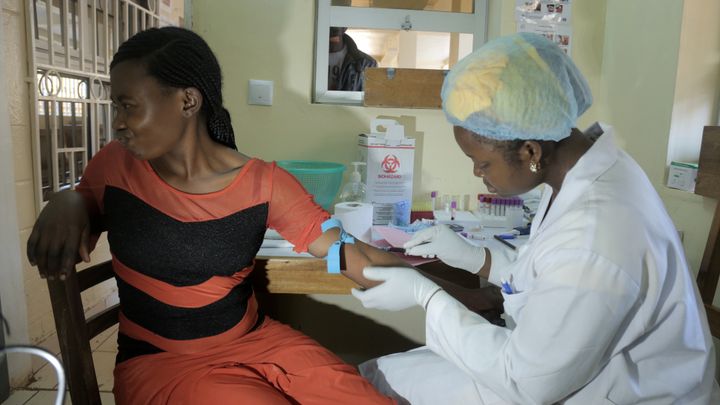
An assistant at the Etoug-Ebe Baptist Hospital, a subsidiary of the Cameroon Baptist Convention Health Services, takes a blood sample of a patient participating in the Novartis Access program to fight non-communicable disease.
Communicable diseases like HIV/AIDS and malaria have taken a terrible toll on Kenya and other African countries over the last 20 years, but both diseases have been tamed in recent years. In 2010, an estimated 51,000 Kenyans died from AIDS, but that number has declined steadily to 36,000 in 2016. Kenya is now considered an HIV success story. The same is true in many other countries.
But now a new epidemic of non-communicable diseases (NCDs) is rising in low- and middle-income countries just as the world is starting to get a handle on communicable diseases, according to the Institute for Health Metrics and Evaluation. The institute reports that the largest contributors to the loss of healthy life are now high blood pressure, smoking, high blood sugar and excess body weight.
Dr. Samuel Mwenda, who knows a thing or two about both epidemics, believes there are lessons we have learned in the fight against communicable diseases that can be applied to NCDs. Mwenda is general secretary and CEO of the Christian Health Association of Kenya (CHAK), a network of Protestant health facilities in Kenya. CHAK supports 46,000 people living with HIV with antiretroviral therapy, representing about 9 percent of the total number of patients nationally.
In 2015, CHAK turned its attention to NCDs: With the support of Novartis Access, it began offering a portfolio of 15 products to treat cardiovascular disease, diabetes, respiratory illness and breast cancer at a price to governments, NGOs and other institutional customers not to exceed $1 per treatment per month. Since then, Novartis Access has also started working in Cameroon, Ethiopia, Pakistan, Rwanda and Uganda.
Here are 10 of the lessons Mwenda says CHAK and other organizations have learned from communicable disease that can also be applied to NCDs:
1) Create partnerships: Partnerships are key. CHAK works with national and local governments, the private sector, academia, professional bodies and supply chain organizations.
2) Mobilize people and increase awareness: We must highlight lifestyle issues such as exposure to smoking and poor diet just like we did with HIV, TB and malaria. Once people are aware, we must provide screening to identify those with high blood pressure and abnormal blood sugars.
3) Refer patients: Once you have flagged people at risk, they have to be linked with health facilities where they can get further assessment, diagnosis and care and treatment.
4) Make treatment available: It’s imperative to have a reliable source of treatment. People will come to facilities when they know there is good quality medication available.
5) Foster psycho-social support: In diabetes, CHAK works with the Kenya Defeat Diabetes Association to mobilize people living with diabetes, helping them form groups for education, encouragement and advocacy.
6) Work with faith groups and communities: In rolling out screening, CHAK links health facilities with churches and communities. This has helped CHAK reach many people at very little cost.
7) Understand it’s a lifelong commitment: We need to commit to taking care of people their entire lives to ensure retention. As in HIV, this requires a lot of hard work in terms of following up to ensure that people come back for treatment.
8) Train health providers: Lower level health cadres like nurses and clinical officers must be trained so they are able to handle diagnosis and treatment of NCDs.
9) Emphasize integration: Those with communicable diseases are also more vulnerable to NCDs. For example, we have begun to screen for hypertension and cervical cancer in HIV programs.
10) Prioritize data: It’s very important to maintain data so we can track the magnitude of the burden and also inform policy and advocate for allocation of resources.
Similarly, Novartis’s work in malaria prompted the company to go into NCDs. “Our work in malaria gave us the experience where we could build on the lessons learned,” says Dr. Nathan Mulure, cluster head for Novartis Social Business for East and Southern Africa. “We brought out a product that was only reaching 100,000 treatments per year and increased that to 100 million treatments. We figured that kind of scaling gave us the experience we needed to try the same thing with NCDs.”
“At ministries of health, I am often asked ‘Why are you doing this? What’s in it for Novartis? Are you sure you’re not hiding anything?’ and I always tell them ’There is nothing hidden. This is a social business model, with low profit, but high turnover, which will help the program to sustain itself over the long term. We hope that if it catches fire, then many more patients will be able to access high quality medicines at prices they can afford.”
NOTE: This article was developed from a session at the 2017 Conference of Christian Connections for International Health on “Lessons from HIV and Malaria for Faith-Based Organizations in Africa’s Transition to Managing NCDs.”